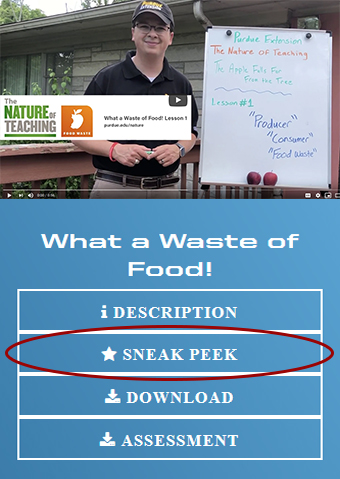 Purdue University - Extension - Forestry and Natural Resources
Purdue University - Extension - Forestry and Natural Resources
Got Nature? Blog
 Calling all teachers and parents: Do you need some new ideas on how to get students out in nature or teach them science lessons?
Calling all teachers and parents: Do you need some new ideas on how to get students out in nature or teach them science lessons?
We’ve got you covered with our Nature of Teaching program. We’ve created more than 40 sneak peek videos that introduce you to our lesson plans, offering a quick way for teachers and other K-12 leaders to view the lessons as well as the related activities.
Many of the lesson plans meet state specifications for Next Generation Science Standards and/or Core Standards, while also offering informal curriculum items and fun activities for all K-12 leaders.
The Nature of Teaching program offers three areas of formal and informal activity-based curricula centered around getting youth outside: wildlife, health and wellness, and food waste.
Sneak Peeks videos include topics ranging from producers, consumers and natural resources and food waste from farm to fork, to exploring nature with your senses and emotional vocabulary exploration, to trees of the Midwest and healthy water/happy home.
Subscribe to the Nature of Teaching YouTube Channel for more Wildlife, Food Waste, and Health and Wellness information.
Resources
Nature of Teaching Website
Nature of Teaching YouTube Channel
Nature of Teaching Program Receives Environmental Education Award, College of Agriculture, Purdue University
Resourceful Animal Relationships, The Education Store, Purdue Extension resource center
The Nature of Teaching: Food Waste Solutions, The Education Store
Benefits of Connecting with Nature, The Education Store
Rod N Williams, Professor of Wildlife Science
Purdue University Department of Forestry and Natural Resources
 The Nature of Teaching, a Purdue Extension signature program, was honored as the third place finisher in the central region for the Environmental Education Award presented by the National Extension Association of Family and Consumer Science (NEAFCS).
The Nature of Teaching, a Purdue Extension signature program, was honored as the third place finisher in the central region for the Environmental Education Award presented by the National Extension Association of Family and Consumer Science (NEAFCS).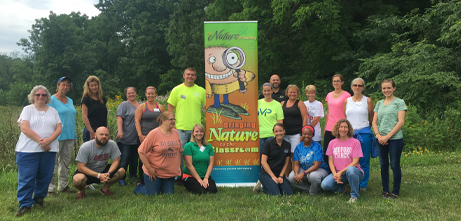 The Nature of Teaching team includes:
The Nature of Teaching team includes:
- Deb Arseneau, HHS Educator, Newton County
- Jarred Brooke, extension wildlife specialist
- Jay Christiansen, health and human sciences extension educator for Vigo County
- Robert Cordes, Maine Department of Inland Fisheries and Wildlife (MDIFW) wildlife special projects coordinator
- Molly Hoag, health and human sciences extension educator for Wells County
- Molly Hunt, health and human sciences extension educator for Delaware County
- Rebecca Koetz, urban ag/home horticulture extension educator for Lake County
- Tami Mosier, 4-H youth development extension educator
- Kelsie Muller, health and human sciences extension educator for Benton County
- Dr. Rod Williams, professor of wildlife science
- Brad Zitscke, Maine Department of Inland Fisheries and Wildlife (MDIFW) assistant regional wildlife biologist
Nature of Teaching
Nature of Teaching YouTube Channel
Transporting Food Waste, The Education Store, Purdue Extension resource center
Resourceful Animal Relationships, The Education Store
Benefits of Connecting with Nature, The Education Store
Welcome to the Nature of Teaching Professional Development Webinar Series: Ecotoxicology Part 1. This webinar shared by Rod Williams, a professor and extension wildlife specialist with Purdue University Extension, and Jason Hoverman, an associate professor at Purdue University and a co-author on the unit on ecotoxicology, discusses the principles of ecotoxicology, contaminants, and threats to the freshwater ecosystems.
This webinar shares the resources teachers, and K-12 leaders, need to teach students about ecotoxicology. This state standard curriculum includes free downloads of posters, photos, charts, data sheets, and fun activities along with the opportunity to receive a Certificate of Completion.
Resources
The Nature of Teaching: Ecotoxicology and Environmental Health, The Education Store, Purdue Extension’s resource center
Benefits of Connecting with Nature, The Education Store
The Nature of Teaching: Disease Ecology, The Education Store
Resourceful Animal Relationships, The Education Store
The Nature of Teaching, YouTube Channel
Nature of Teaching, Website
Rod Williams, Professor of Wildlife Science
Purdue University Department of Forestry and Natural Resources
Jason Hoverman, Associate Professor Vertebrate Ecology
Purdue University Department of Forestry and Natural Resources
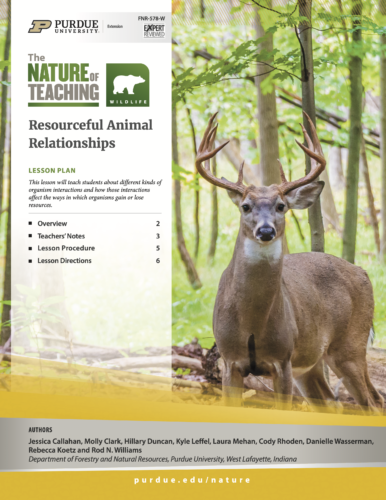 Resourceful Animal Relationships is one unit in a series available from The Nature of Teaching – the place to go for teaching resources that focus on wildlife, food waste, health and wellness. In this series teachers can find free lesson plans, printables, posters, a photo library, information on upcoming workshops and more.
Resourceful Animal Relationships is one unit in a series available from The Nature of Teaching – the place to go for teaching resources that focus on wildlife, food waste, health and wellness. In this series teachers can find free lesson plans, printables, posters, a photo library, information on upcoming workshops and more.
This lesson will teach third- through fifth-grade students about different kinds of organism interactions and how those interactions affect the ways in which organisms gain or lose resources. Students will learn how to describe the differences between mutualism, parasitism,
and competition along with how to explain the different effects that relationships have on an organism and their resources.
It meets several grade-appropriate Next Generation Science Standards, English/Language Arts Standards, and Math Standards. This 19-page pdf is written by Dr. Rod Williams.
For more resources, please check the Education Store.
Resources
Benefits of Connecting with Nature, The Education Store, Purdue Extension resource center
The Nature of Teaching: Ecotoxicology and Environmental Health, The Education Store
The Nature of Teaching: Disease Ecology, The Education Store
The Nature of Teaching: Adaptations for Aquatic Amphibians, The Education Store
Adaptations for Aquatic Amphibians Activity 2: Water Quality Sneak Peak, Video, Purdue Extension YouTube channel
Rod Williams, Professor of Wildlife Science
Purdue University Department of Forestry and Natural Resources
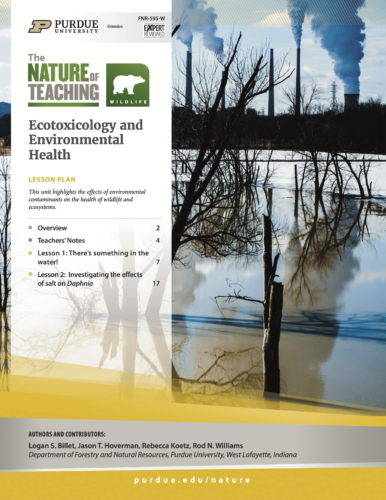 The Nature of Teaching: Ecotoxicology and Environmental Health is one unit in a series available from The Nature of Teaching – the place to go for teaching resources that focus on wildlife, food waste, health and wellness. In this series teachers can find free lesson plans, printables, posters, a photo library, information on upcoming workshops and more.
The Nature of Teaching: Ecotoxicology and Environmental Health is one unit in a series available from The Nature of Teaching – the place to go for teaching resources that focus on wildlife, food waste, health and wellness. In this series teachers can find free lesson plans, printables, posters, a photo library, information on upcoming workshops and more.
This unit highlights the effect of environmental contaminants on the health of wildlife and ecosystems with two lessons filled with worksheets, activities, lab report grading rubric sheet and more.
Lesson 1: There’s Something in the Water!
Lesson 2: Investigating the Effects of Salt Contamination on Daphnia
This 33-page PDF is written by Dr. Jason Hoverman; Logan Billet, Rebecca Koetz and Dr. Rod Williams.
For more resources, please check the Education Store.
Resources
Benefits of Connecting with Nature, The Education Store, Purdue Extension resource center
The Nature of Teaching: Disease Ecology, The Education Store
Resourceful Animal Relationships, The Education Store
The Nature of Teaching: Food Waste and the Environment, The Education Store
Adaptations for Aquatic Amphibians Activity 2: Water Quality Sneak Peak, Video, Purdue Extension YouTube channel
Rod Williams, Professor of Wildlife Science
Purdue University Department of Forestry and Natural Resources
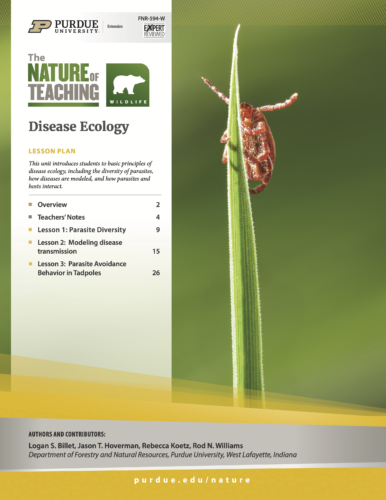 The Nature of Teaching: Disease Ecology is one unit in a series available from The Nature of Teaching – the place to go for teaching resources that focus on wildlife, food waste, health and wellness. In this series teachers can find free lesson plans, printables, posters, a photo library, information on upcoming workshops and more.
The Nature of Teaching: Disease Ecology is one unit in a series available from The Nature of Teaching – the place to go for teaching resources that focus on wildlife, food waste, health and wellness. In this series teachers can find free lesson plans, printables, posters, a photo library, information on upcoming workshops and more.
This unit introduces students to basic principles of disease ecology, including the diversity of parasites, how diseases are modeled, and how parasites and hosts interact. It includes three lessons with colorful animal cards to print along with worksheets and presentation.
Lesson 1: Parasite Diversity Activity
Lesson 2: Modeling Disease Transmission
Lesson 3: Parasite Avoidance Behavior in Tadpoles
This 33-page download PDF is written by Dr. Jason Hoverman; Logan Billet, Rebecca Koetz and Dr. Rod Williams.
For more resources, please check the Education Store.
Resources
Benefits of Connecting with Nature, The Education Store, Purdue Extension resource center
The Nature of Teaching: Ecotoxicology and Environmental Health, The Education Store
Resourceful Animal Relationships, The Education Store
The Nature of Teaching: Food Waste and the Environment, The Education Store
Rod Williams, Professor of Wildlife Science
Purdue University Department of Forestry and Natural Resources
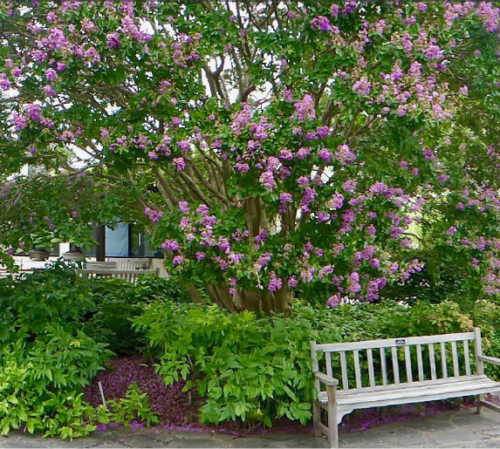 Trees provide many benefits and value to property owners in functional, aesthetic, social, environmental, and even economic ways. Functional benefits include mitigating climate change by storing carbon, removing pollution from the atmosphere, managing stormwater runoff, and improving air quality. Trees provide oxygen and many other benefits – such as shade, which can impact home cooling costs.
Trees provide many benefits and value to property owners in functional, aesthetic, social, environmental, and even economic ways. Functional benefits include mitigating climate change by storing carbon, removing pollution from the atmosphere, managing stormwater runoff, and improving air quality. Trees provide oxygen and many other benefits – such as shade, which can impact home cooling costs.
The collective value of trees makes a difference in people’s health and quality of life in cities and towns everywhere. This updated Purdue Extension publication Tree Appraisal and the Value of Trees describes methods used to appraise trees and landscapes that can determine their value and worth, reasons why a tree should be appraised, the factors that go into tree appraisal, what appraisal ratings mean, and sample scenarios.
Resources
The Nature of Teaching: Trees of the Midwest, The Education Store, Purdue Education Resource Center
Corrective Pruning for Deciduous Trees, The Education Store
Resources and Assistance Available for Planting Hardwood Seedlings, The Education Store
Tree Support Systems, The Education Store
Purdue University, Department of Forestry and Natural Resources
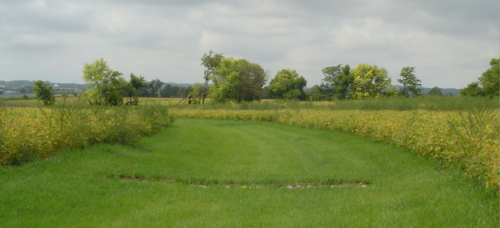 Agricultural Best Management Practices (BMPs) are intended to protect or improve water quality without significantly impacting production. This resource titled Tipping Point Planner Stormwater Definitions, Agricultural Best Management Practices, helps communities plan for a sustainable future. Authored by Ben Wegleitner, social science outreach associate, Daniel Walker, community planning extension specialist, Kara A Salazar, assistant program leader and extension specialist for sustainable communities, and Lydia Utley, data analyst, you will find references and get an overview of how the Tipping Point Planner program guides you through best management practices.
Agricultural Best Management Practices (BMPs) are intended to protect or improve water quality without significantly impacting production. This resource titled Tipping Point Planner Stormwater Definitions, Agricultural Best Management Practices, helps communities plan for a sustainable future. Authored by Ben Wegleitner, social science outreach associate, Daniel Walker, community planning extension specialist, Kara A Salazar, assistant program leader and extension specialist for sustainable communities, and Lydia Utley, data analyst, you will find references and get an overview of how the Tipping Point Planner program guides you through best management practices.
In this Long-Term Hydrologic Impact Assessment (L-THIA) model and the Tipping Point Planner program you will find the following BMPs: no-till practices, buffer strips, grassed waterway, nutrient management, grade stabilization structure and blind inlet.
With help from trained facilitators, the Tipping Point Planner program enables professional and citizen participation in the land use planning and management process.
Resources
Tipping Point Planner, Sustainable communities, Purdue University
Urban Best Management & Low Impact Development Practices, The Education Store, Purdue Extension resource center
Bioindicators of Water Quality: Quick Reference Guide, The Education Store
Improving Water Quality by Protecting Sinkholes on Your Property, video, The Education Store
Improving Water Quality At Your Livestock Operation, video, The Education Store
Improving Water Quality Around Your Farm, video, The Education Store
Healthy Water, Happy Home – Lesson Plan, The Education Store
Kara A Salazar, Assistant Program Leader and Extension Specialist for Sustainable Communities
Purdue University Department of Forestry and Natural Resources
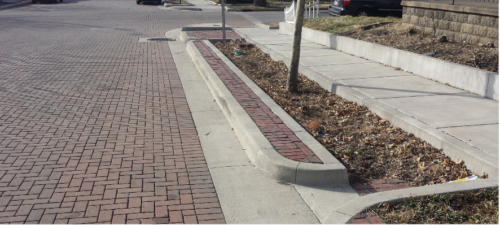 Urban best management practices (BMPs) and low-impact development practices are forms of green infrastructure designed to protect water quality and quantity by reducing stormwater runoff or by storing and treating stormwater before it reaches surface waters. Low-impact development practices are intended to mimic natural infiltration processes.
Urban best management practices (BMPs) and low-impact development practices are forms of green infrastructure designed to protect water quality and quantity by reducing stormwater runoff or by storing and treating stormwater before it reaches surface waters. Low-impact development practices are intended to mimic natural infiltration processes.
This publication titled Tipping Point Planner Stormwater Definitions: Urban Best Management Practices (BMPs) and Low Impact Development Practices is written by Ben Wegleitner, social science outreach associate, Daniel Walker, community planning extension specialist, Kara A Salazar, assistant program leader and extension specialist for sustainable communities, and Lydia Utley, data analyst. It discusses the benefits of several urban best management practices for protecting or improving water quality. These BMPs include: permeable pavement, rain barrels, bioretention system, grass strip (or buffer strip), grassed swale, retention ponds, wetland basin and detention basin. The following practices are used in the Long-Term Hydrologic Impact Assessment (L-THIA) model and the Tipping Point Planner. Through Tipping Point Planner, Great Lakes communities can plan sustainable futures by directly linking data to their local decision-making processes.
Resources
Tipping Point Planner Stormwater Definitions: Agricultural Best Management Practices, The Education Store, Purdue Extension resource center
Improving Water Quality by Protecting Sinkholes on Your Property, video, The Education Store
Improving Water Quality At Your Livestock Operation, video, The Education Store
Improving Water Quality Around Your Farm, video, The Education Store
Healthy Water, Happy Home – Lesson Plan, The Education Store
Kara A Salazar, Assistant Program Leader and Extension Specialist for Sustainable Communities
Purdue University Department of Forestry and Natural Resources
Six pieces of data to collect from deer you harvest this year
Deer season is upon us in Indiana! If you are a serious hunter and deer manager, here are some things you should consider collecting from deer you harvest. This data provides valuable insights to the deer herd condition, and when combined with hunter observation data and habitat data, like browse transects, you can get a clear picture of the deer herd and habitat quality on your property. However, one year of harvest data is unlikely to be much of value, but collecting data over multiple years can help you track trends in the herd and habitat quality.
What to collect
When you harvest a deer on your property you should consider collecting the following pieces of biological information:
- Sex
- Age
- Weight
- Lactation status
- Antler measurements
- Rumen contents
*Each deer you harvest should be assigned a unique ID number to be sure all the following data is assigned to the right deer.
Sex and Age
Collecting deer sex and age (based on tooth replacement and wear) can help you divide the rest of the data you collect into sex and age classes. Find out how to determine age by viewing Age Determination in White-Tailed Deer video. You do not 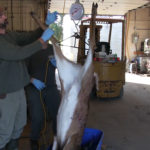 necessarily have to age a deer to the exact year, but you should separate ages into at least 3 age classes; fawns, yearlings, and >= 2.5 years old. This can be important for tracking changes to the average weight per age class or average antler measurements per age class over time.
necessarily have to age a deer to the exact year, but you should separate ages into at least 3 age classes; fawns, yearlings, and >= 2.5 years old. This can be important for tracking changes to the average weight per age class or average antler measurements per age class over time.
Weight
You can collect either live weights or dressed weights, but you should pick one or the other and collect all weights consistently. Be sure to test your scales for accuracy before weighing deer. Tracking changes to the average weight per age class can provide 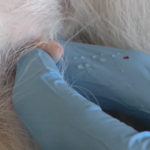 information about the nutritional status of the herd.
information about the nutritional status of the herd.
Lactation Status
Lactation status of does is often used as an index of fawn recruitment and can help determine if a doe had a fawn the summer preceding the hunting season. Lactation status for does harvested early in the season can be checked by squeezing the teats to produce milk you may need to cut into the mammary gland on does harvested later in the season to check lactation status.
Antler measurements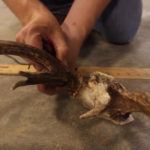
Antler measurements should be collected from bucks harvested on your property, including yearlings. Find out how to measure the antlers by viewing How to Score Your White-Tailed Deer video. At a minimum, you should collect the number of points on each antler and the basal circumference of the main beams. You may also consider collecting the inside spread of the antlers and the main beam lengths. Additionally, you can collect the gross Boone & Crockett Score.
Rumen contents
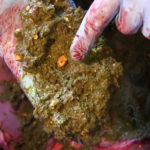 This piece of data can be helpful from a scouting and hunting aspect. Looking into the rumen of a deer can help you determine what deer may be eating during the portion of the year the deer was harvested. You may find green material (which can be hard to identify), corn, acorns, or whatever else deer may be consuming.
This piece of data can be helpful from a scouting and hunting aspect. Looking into the rumen of a deer can help you determine what deer may be eating during the portion of the year the deer was harvested. You may find green material (which can be hard to identify), corn, acorns, or whatever else deer may be consuming.
Things you need to collect harvest data
Here is a list of items you might need to collect data from harvested deer.
- Jawbone extractor
- Knife
- Loppers
- Scale
- Jawbone tag or permanent marker
- Flexible measuring tape
- Datasheet (click here for a white-tailed deer harvest datasheet)
Putting all of this data together can give you a picture into the condition of the deer herd on your property. Collecting this data only takes a small amount of time and effort and the information you gather is well worth it! For more information of how to collect biological data from harvested deer, check out this video from Purdue Extension.
Help the Indiana Department of Natural Resources (IDNR) collect biological data from harvested deer
Most of the data we discussed in this blog post and that is covered in the White-Tailed Deer Post Harvest Collection video, are data the Indiana DNR is collecting through an online post-harvest survey. This is a great opportunity for hunters to help the DNR collect data that will be used to manage the deer herd throughout the state. More information about the after the hunt survey can be found by visiting the Indiana DNR Deer After Hunt Survey page. If you are successful in harvesting a deer in Indiana this year, be sure to check your email for a link to the survey.
Additional Resources:
Age Determination in White-Tailed Deer video, Purdue Extension – FNR YouTube Playlist
How to Score Your White-Tailed Deer video, Purdue Extension – FNR YouTube Playlist
White-Tailed Deer Post Harvest Collection video, Purdue Extension – FNR YouTube Playlist
White-Tailed Deer Harvest Log (pdf), Purdue Extension-FNR
Indiana Deer Hunting, Biology and Management, Indiana Department of Natural Resources (IDNR)
Indiana Hunting and Trapping Guide, Indiana Department of Natural Resources (IDNR)
Managing White-Tailed Deer: Collecting Data from Harvested Deer, Alabama Cooperative Extension System
Jarred Brooke, Wildlife Extension Specialist
Department of Forestry & Natural Resource, Purdue University
Recent Posts
- Purdue Alumnus Magazine Highlights FNR Graduate and Nature of Teaching Program
Posted: September 13, 2024 in Got Nature for Kids, Nature of Teaching, Wildlife - Indiana Natural Resources Teacher Institute Workshop – Welcome to the Forest!
Posted: February 15, 2024 in Forestry, Natural Resource Planning, Nature of Teaching, Plants, Wildlife, Woodlands - Nature of Teaching, Connecting Youth With Nature for Health and Education – ANR
Posted: February 6, 2024 in Forestry, How To, Land Use, Nature of Teaching, Plants, Wildlife, Woodlands - Asian jumping worms: Where to get started – Landscape Report
Posted: April 27, 2023 in Invasive Insects, Nature of Teaching, Wildlife, Woodlands - Publication-Preparing Indiana’s Urban Forest for Climate Change
Posted: February 7, 2023 in Forestry, Forests and Street Trees, How To, Nature of Teaching, Plants, Publication, Urban Forestry, Woodlands - Another Successful Natural Resources Teacher Institute Forestry Educational Workshop
Posted: July 12, 2022 in Forestry, Nature of Teaching, Wildlife, Woodlands - New Curriculum Available: How Humans Impact Gene Flow and Genetic Diversity
Posted: June 2, 2021 in Nature of Teaching, Publication - Jarred Brooke Receives PK-12 Council Staff Excellence Award
Posted: April 15, 2021 in Aquaculture/Fish, Aquatic/Aquaculture Resources, Forestry, Natural Resource Planning, Nature of Teaching - Nature of Teaching Virtual Workshops With Certifications
Posted: March 23, 2021 in How To, Nature of Teaching, Wildlife - Publication: Transporting Food Waste
Posted: January 5, 2021 in How To, Nature of Teaching, Publication
Archives
Categories
- Alert
- Aquaculture/Fish
- Aquatic/Aquaculture Resources
- Ask the Expert
- Christmas Trees
- Community Development
- Disease
- Drought
- Forestry
- Forests and Street Trees
- Gardening
- Got Nature for Kids
- Great Lakes
- How To
- Invasive Animal Species
- Invasive Insects
- Invasive Plant Species
- Land Use
- Natural Resource Planning
- Nature of Teaching
- Plants
- Podcasts
- Ponds
- Publication
- Safety
- Spiders
- Timber Marketing
- Uncategorized
- Urban Forestry
- Webinar
- Wildlife
- Wood Products/Manufacturing
- Woodland Management Moment
- Woodlands
